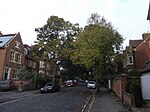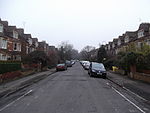St Margaret's Church, Oxford
1893 establishments in EnglandChurch of England church buildings in OxfordChurches completed in 1893Grade II listed buildings in OxfordGrade II listed churches in Oxfordshire ... and 1 more
St John's College, Oxford

St Margaret's Church is a church in North Oxford, England. It is near the northern end of Kingston Road, at the corner of St Margaret's Road. The church was built between 1883 and 1893. The building is Grade II listed. The parish War Memorial adjoins the southwestern end of St. Margaret's churchyard. Dedicated in 1920, it is in the form of a calvary.
Excerpt from the Wikipedia article St Margaret's Church, Oxford (License: CC BY-SA 3.0, Authors, Images).St Margaret's Church, Oxford
St Margaret's Road, Oxford North Oxford
Geographical coordinates (GPS) Address External links Nearby Places Show on map
Geographical coordinates (GPS)
| Latitude | Longitude |
|---|---|
| N 51.766725 ° | E -1.268505 ° |
Address
Saint Margaret's Church
St Margaret's Road
OX2 6RU Oxford, North Oxford
England, United Kingdom
Open on Google Maps










